2523ss01 - 05052016
2523ss01 - 05052016.docx
NSPS for Crude Oil and Natural Gas Facilities for Construction, Modification, or Reconstruction Commenced After September 18, 2015 (40 CFR part 60, subpart OOOOa) (Proposed Rule)
OMB: 2060-0721
SUPPORTING STATEMENT
NSPS for Crude Oil and Natural Gas Facilities for which Construction, Modification or Reconstruction Commenced After September 18, 2015 (40 CFR part 60, subpart OOOOa).
PART A
1.0 Identification of the Information Collection
(a) Title and Number of the Information Collection.
NSPS for Crude Oil and Natural Gas Facilities for Construction, Modification, or Reconstruction Commenced After September 18, 2015 (40 CFR part 60, subpart OOOOa). This is a new information collection request (ICR), and the EPA tracking number is 2523.01.
(b) Short Characterization.
This ICR covers information collection requirements in the new source performance standards (NSPS) for Crude Oil and Natural Gas Facilities (40 CFR part 60, subpart OOOOa). The information collected will be used by the EPA and delegated state and local agencies to determine the compliance status of affected facilities subject to the rule.
The oil and natural gas sector includes operations involved in the extraction and production of oil and natural gas, as well as the processing, transmission, and distribution of natural gas.
On June 24, 1985 (50 FR 26122), the EPA promulgated an NSPS for the Crude Oil and Natural Gas Production category which addressed emissions of volatile organic compounds (VOC) from leaking equipment at onshore natural gas processing plants (40 CFR part 60, subpart KKK). These standards apply to the following affected facilities constructed, modified or reconstructed after January 20, 1984, located at onshore natural gas processing plants: a compressor in VOC service or in wet gas service, and the groups of all equipment (except compressors) within a process unit. A process unit is defined as the equipment assembled for extraction of natural gas liquids from field gas, fractionation of liquids into natural gas products, or other processing of natural gas products.
The NSPS for Onshore Natural Gas Processing - SO2 Emissions (40 CFR part 60, subpart LLL) were promulgated on October 1, 1985. These standards apply to the following affected facilities located at onshore natural gas processing plants and constructed after January 20, 1984: each sweetening unit, and each sweetening unit followed by a sulfur recovery unit. A sweetening unit is defined as a process device that separates the hydrogen sulfide and carbon dioxide (CO2) contents from the sour natural gas stream. The provisions of subpart LLL do not apply to sweetening facilities that produce acid gas that is completely re-injected into oil or gas bearing geologic strata or that is otherwise not released to the atmosphere. The control and monitoring requirements of subpart LLL do not apply to affected facilities with design capacities of less than two long tons per day (LT/D) of hydrogen sulfide in the acid gas, expressed as sulfur.
As part of the mandatory review of NSPS required under the Clean Air Act, the requirements of subpart KKK and subpart LLL were issued in a new subpart, 40 CFR part 60, subpart OOOO, promulgated on August 16, 2012 . The existing provisions of subparts KKK and LLL were included in the new subpart OOOO along with new standards regulating VOC for the following affected facilities in the extraction and production sector of the oil and gas industry: gas wells, pneumatic controllers, centrifugal and reciprocating compressors, and storage vessels.
The EPA is finalizing amendments to subpart OOOO due to reconsideration of certain issues raised in petitions for reconsideration that were received by the Administrator, which include implementation improvements. The EPA is also finalizing a new subpart, 40 CFR part 60, subpart OOOOa, which includes: standards for GHG emissions (in the form of limitations on methane) from certain facilities that are covered by current VOC standards in the oil and natural gas source category, and standards for GHG and VOC emissions from facilities across the source category that are currently unregulated, including hydraulically fractured oil well completions; fugitive emissions from well sites and compressor stations; pneumatic pumps; and centrifugal compressors, reciprocating compressors and pneumatic controllers in the transmission and storage segment.
The potential respondents are owners or operators of oil and natural gas affected facilities as defined under subpart OOOOa. All of the oil and natural gas facilities located in the United States are owned and operated by the oil and natural gas industry (the “Affected Public”). None of the facilities in the United States are owned or operated by state, local, tribal or the Federal government. All facilities are privately owned for-profit businesses.
In general, all NSPS standards require initial notifications, performance tests, and periodic reports. Owners or operators are also required to maintain records of calculations and compliance determinations. These notifications, reports, and records are essential in determining compliance, and are required of all owners and operators of affected facilities subject to NSPS.
We estimate an average of 2,554 operators will be affected by subpart OOOOa over the three year period. The average annual burden for the recordkeeping and reporting requirements in subpart OOOOa for these owner and operators that are subject to the Oil and Natural Gas Production, and Natural Gas Transmission and Distribution NSPS is 98,438 person-hours, with an average annual cost of $3,361,074 over the three year period.
2. Need For and Use of the Collection
(a) Need/Authority for the Collection.
The EPA is charged under section 111 of the Clean Air Act (CAA), as amended, to establish standards of performance for new stationary sources that reflect:
. . . application of the best technological system of continuous emissions reduction which (taking into consideration the cost of achieving such emissions reduction, or any non-air quality health and environmental impact and energy requirements) the Administrator determines has been adequately demonstrated. Section 111(a)(l).
The Agency refers to this charge as selecting the best system of emissions reduction (BSER). Section 111 also requires that the Administrator review and, if appropriate, revise such standards every 8 years.
In addition, section 114(a) states that the Administrator may require any owner or operator subject to any requirement of this Act to:
establish and maintain such records;
make such reports;
install, use, and maintain such monitoring equipment;
use such audit procedures, or methods;
sample such emissions (in accordance with such procedures or methods, at such locations, at such intervals, during such periods, and in such manner as the Administrator shall prescribe);
keep records on control equipment parameters, production variables or other indirect data when direct monitoring of emissions is impractical;
submit compliance certifications in accordance with Section 114(a)(3); and
provide such other information as the Administrator may reasonably require.
(b) Use/Users of the Data.
The information will be used by the delegated authority (state agency, or Regional Administrator if there is no delegated state agency) to ensure that the standards and other requirements are being achieved. Based on review of the recorded information at the site and the reported information, the delegated permitting authority can identify facilities that may not be in compliance and decide which facilities, records, or processes may need inspection.
3. Nonduplication, Consultations, and Other Collection Criteria
(a) Nonduplication.
Where it has been deemed applicable, the recordkeeping and reporting requirements for this NSPS have been developed following the similar reporting requirements as outlined in “Mandatory Reporting of Greenhouse Gases: Subpart W Oil and Natural Gas” in 40 CFR 98.2 and 40 CFR 98.4. By remaining consistent with subpart W, we have attempted to reduce the burden required to monitor and show compliance. In addition, if a State or local agency has adopted their own similar standards to implement the Federal standards, a copy of the report submitted to the state or local agency can be sent to the Administrator in lieu of the report required by the Federal standards.0 Therefore, no duplication exists.
(b) Public Notice Required Prior to ICR Submission to OMB.
The associated proposed rule document provides public notice and solicit public comment on this ICR. All comments received will be addressed in the ICR for the final rule.
(c) Consultations.
In developing the rule, the EPA performed a comprehensive review of existing state rules and industry standards, visited oil and natural gas sites, as well as consulted with individual companies, state agencies, and environmental groups. The main organizations that provided expert advice during the development of this rule include the Agency’s industry experts.
(d) Effects of Less Frequent Collection.
Respondents must monitor all specified criteria at each affected facility and maintain these records for 5 years. The reporting frequency to the EPA has been established to minimize the burden on owners and operators of affected facilities.
(e) General Guidelines.
This collection of information is consistent with all OMB guidelines established by OMB at 5 CFR part 1320, section 1320.5.
(f) Confidentiality.
All information submitted to the Agency for which a claim of confidentiality is made will be safeguarded according to the Agency policies set forth in Title 40, Chapter 1, Part 2, Subpart B--Confidentiality of Business Information (see 40 CFR 2; 41 FR 36902, September 1, 1976; amended by 43 FR 39999, September 28, 1978; 43 FR 42251, September 28, 1978; 44 FR 17674, March 23, 1979).
(g) Sensitive Questions.
This section is not applicable because this ICR does not involve matters of a sensitive nature.
4. The Respondents and the Information Requested
(a) Respondents/NAICS Codes.
Potential respondents under subpart OOOOa are owners or operators of new, modified or reconstructed oil and natural gas affected facilities as defined under the rule. The North American Industry Classification System (NAICS) codes for the oil and gas industry include: 211111 (Crude Petroleum and Natural Gas Extraction); 211112 (Natural Gas Liquid Extraction); 221210 (Natural Gas Distribution); 486110 (Pipeline Distribution of Crude Oil); 486210 (Pipeline Transportation of Natural Gas).
(b) Information Requested.
(i) Data Items, Including Recordkeeping Requirements.
Recordkeeping |
|
For well affected facilities, record location and well identification information. Maintain completion log records for each completion operation. For wells exempt from one or more requirements, maintain records to support exemption. |
60.5375a(b); 60.5410a(a); 60.5415a(a); 60.5420a(c)(1) |
For well affected facilities with less than or equal to 300 scf of gas per stock tank barrel of oil produced, keep records to demonstrate exemption. |
60.5375a(g)(2); 60.5420a(c)(1)(vi). |
For centrifugal compressor affected facilities, maintain records related to equipment, purchase, location, and control. Develop site-specific monitoring plan. Maintain compliance records for control device including continuous parameter monitoring results, visible emission observation results, inspection results, corrective actions, and maintenance. Maintain certification of closed vent system capacity; record results of closed vent system and by-pass inspections, maintenance, and corrective actions. |
60.5380a(d); 60.5410a(b)(8); 60.5411a(a)(3)(i)(A); 60.5411a(d); 60.5412a(c) and (d); 60.5413a(d) and (e); 60.5415a(b); 60.5416a(a) and (b); 60.5417a(c), (e), and (f); 60.5420a(c)(2) and (17). |
For reciprocating compressor affected facilities, maintenance records of rod packing replacement and operating data. |
60.5385a(d); 60.5410a(c)(4); 60.5415a(c); 60.5420a(c)(3) |
For reciprocating compressor affected facilities that collect emissions through a closed vent system to a process, maintain certification of closed vent system capacity; record results of closed vent system and by-pass inspections, maintenance, and corrective actions. |
60.5385a(d); 60.5410a(c)(4); 60.5411a(a)(3)(i)(A); 60.5411a(d); 60.5416a(a) and (b)(13); 60.5420a(c)(3) and (17). |
For pneumatic controller affected facilities, maintain information related to equipment, purchase, and location. Requirements to tag devices. Documentation of bleed rate and justification for use of device > 6 scfh. |
60.4390a(a), (b)(2), (c)(2), (f); 60.5410a(d)(4) and (6); 60.5413a(d)(3); 60.5420a(c)(4) |
For pneumatic pump affected facilities that are not controlled, maintain information related to equipment, purchase, location, and manufacturer specifications. Prepare and submit applicable certification and maintain records. Maintain information related to equipment, purchase, location, and manufacturer specifications. |
60.5393a(b)(3)-(5); 60.5393a(e); 60.5410a(e)(8); 60.5420a(c)(16) |
For pneumatic pump affected facilities that are controlled, maintain information related to equipment, purchase, location, manufacturer specifications, and control. Maintain certification of closed vent system capacity; record results of closed vent system and by-pass inspections, maintenance, and corrective actions. |
60.5393a(e); 60.5410a(e)(8); 60.5420a(c)(16); 60.5411(a)(3)(i)(A); 60.5411a(d); 60.5416a(a) and (b)(13); 60.5420a(c)(16) and (17). |
For storage vessel affected facilities, Maintain compliance records for control device including visible emission observation results, inspection results, corrective actions, and maintenance. Maintain certification of closed vent system capacity; record results of closed vent system and by-pass inspections, maintenance, and corrective actions. |
60.55395a(d)(3); 60.5411a(c)(3)(i)(A); 60.5411a(d); 60.5412a(c) and (d); 60.5413a(d) and (e); 60.5416a(c); 60.5417a(h)60.5420a(c)(12), (13), (14), and (17). |
For the collection of fugitive emission components at well sites affected facilities, develop company-defined area monitoring plans. Maintain records of each semi-annual monitoring survey. |
60.5397a(b), (c), (i), 60.5410a(i); 60.5415a(h); 60.5420a(c)(15) |
For the collection of fugitive emission components at compressor station affected facilities, develop company-defined area monitoring plans. Maintain records of each quarterly monitoring survey. |
60.5397a(b), (c), (i), 60.5410a(i); 60.5415a(h); 60.5420a(c)(15) |
For affected facilities at onshore gas processing plants, records of subject equipment, records of leak detection and repair program. |
60.5400a(a) 60.482-1a(b) and (d); 60.482-7a; 60.482-10a |
For sweetening unit affected facilities at onshore natural gas processing plants, records of sulfur levels, acid gas, calculations, measurements, and compliance records. |
60.5407a(a); 60.5423a |
Notifications and Reporting |
|
Notify the Administrator at least two days prior to a well completion operation. |
60.5420a(a)(2) |
Submit an annual report, per operating entity, for all wellhead, pneumatic controller, pneumatic pump, storage vessel, centrifugal and reciprocating compressor and wellsite and compressor station fugitive emissions affected facilities. |
60.5420a(b) |
Notification of construction or reconstruction. |
60.7(a)(1) |
Notification of performance test. |
60.8(d) |
Annual reports including those of excess emissions. |
60.5417a(c); 60.487a(c)( 2)(i)-(vi) |
Performance test results. |
60.487a(e) |
Semiannual report on excess emissions from and performance of continuous monitoring system, and/or summary report forms at processing plants |
60.5422a(b) |
Annual report on excess emissions from and performance of continuous monitoring system for sweetening units. |
60.5410a(g )(3); 60.5423a(b) |
(ii) Respondent Activities.
Respondent Activities |
Read instructions. |
Gather relevant information. |
Perform initial performance test and repeat performance tests if necessary. |
Write the notifications and reports listed above. |
Enter information required to be recorded above. |
Submit the required reports developing, acquiring, installing, and utilizing technology and systems for the purpose of collecting, validating, and verifying information. |
Develop, acquire, install, and utilize technology and systems for the purpose of processing and maintaining information. |
Develop, acquire, install, and utilize technology and systems for the purpose of disclosing and providing information. |
Adjust the existing ways to comply with any previously applicable instructions and requirements. |
Train personnel to be able to respond to a collection of information. |
Transmit, or otherwise disclose the information. |
5. The Information Collected–Agency Activities, Collection Methodology, and Information Management
(a) Agency Activities.
The Agency activities associated with subpart OOOOa are provided in Tables 2a-2d (located at the end of this supporting statement) and are introduced in section 6(c).
(b) Collection Methodology and Management.
Data and records maintained by the respondents are tabulated and published for use in compliance and enforcement programs of the delegated permitting authority. Information contained in the reports will be required to submit records electronically to the EPA’s Central DATA Exchange (CDX) using the Compliance and Emissions Data Reporting Interface (CEDRI). CDX enables fast, efficient and more accurate environmental data submissions from state and local governments, industry and tribes to the EPA and participating program offices. The EPA's CDX is the point of entry on the Environmental Information Exchange Network (Exchange Network) for environmental data submissions to the Agency. CDX works with both EPA program offices looking for a way to better manage incoming data, and stakeholders looking for a way to reduce burden from reporting requirements.
(c) Small Entity Flexibility.
The EPA performed a screening analysis for impacts on a sample of expected affected small entities by comparing compliance costs to entity revenues. The impact on small entities (i.e., small businesses) was taken into consideration during the development of the regulation. The EPA nonetheless has tried to reduce the impact of this rule on small entities by the selection of highly cost-effective controls and specifying monitoring requirements that are the minimum to insure compliance.
(d) Collection Schedule.
The specific frequency for each information collection activity within this request is shown in Tables 1a-1d.
6. Estimating the Burden and Cost of the Collection
(a) Estimating Respondent Burden.
This ICR uses the following labor rates: $34.18 per hour for technical labor, $53.91 per hour for management labor, and $23.90 for clerical labor. The rates have already been increased by 110 percent to account for the benefit packages available to those employed by private industry. These rates are from the Employer Costs for Employee Compensation Historical Listing March 2004 – December 2010 published by the Bureau of Labor and Statistics updated to 2012 (a 2 percent increase from 2008) in accordance with BLS current employment statistics (Source: ftp://ftp.bls.gov/pub/special.requests/ocwc/ect/ececqrtn.pdf, update http://www.bls.gov/ces/). Costs have been estimated in 2012 dollars for this ICR to be consistent with other costs (i.e. cost of control) estimated in the development of subpart OOOOa.
The annual burden estimates for the subpart OOOOa are shown in Tables 1a-1d. These numbers were derived from estimates of new sources that would be required to meet the standards based on the EPA’s development of impacts for this rulemaking. Note that Tables 1a, 1b and 1c include the comprehensive technical, managerial, and clerical hours and associated costs for reporting and recordkeeping required by subpart OOOOa. However, the reporting and recordkeeping costs for the fugitive emission standards for components at well sites and compressor stations were also included in the total program costs estimated in the Technical Support Document (TSD) for the final standards. In order to avoid double-counting of these impacts, the hours and costs associated with this fugitive program in Tables 1a, 1b and 1c were not included in the totals reported in Table 1d.
(b) Estimating Respondent Costs.
The information collection activities for subpart OOOOa are presented in Tables 1a-1d. Because the data are already collected by respondents as part of normal operations, no respondent development costs are associated with the information collection activities.
(i) Estimating Labor Costs.
(ii) Estimating Capital and Operations and Maintenance (O&M) Costs. We do not estimate there will be additional capital and O&M monitoring costs for the newly affected facilities.
(c) Estimating Agency Burden and Cost.
Because reporting and recordkeeping requirements on the part of the respondents are required under the operating permits rules in 40 CFR part 70 or part 71 and the part 60 NSPS General Provisions, no operational costs will be incurred by the Federal Government. Publication and distribution of the information are part of the Compliance Data System, with the result that no Federal costs can be directly attributed to the ICR. Examination of records to be maintained by the respondents will occur incidentally as part of the periodic inspection of facilities that is part of the EPA’s overall compliance and enforcement program, and, therefore, is not attributable to the ICR. The only costs that the Federal government will incur are user costs associated with the analysis of the reported information, as presented in Tables 2a-2d.
This cost is based on the average hourly labor rate as follows:
Managerial $62.27 (GS-13, Step 5, $38.92 + 60%)
Technical $46.21 (GS-12, Step 1, $28.88 + 60%)
Clerical $25.01 (GS-6, Step 3, $15.63 + 60%)
These rates are from the Office of Personnel Management (OPM), 2012 General Schedule rates of pay, which excludes locality. The rates have been increased by 60 percent to account for the benefit packages available to government employees. Costs have been estimated in 2012 dollars for this ICR to be consistent with other costs (i.e., cost of control) estimated in the development of subpart OOOOa.
(d) Estimating the Respondent Universe and Total Burden and Costs.
It was estimated that an average of 2,554 operators per year will be subject to subpart OOOOa during the 3-year period of this ICR. This value encompasses the number of companies that we expect will submit reports separately as its own entity.
For subpart OOOOa, the components of the total annual responses attributable to this ICR are notification of construction, reconstruction and modification for an average of 8 processing plants and sweetening units per year, notification (by 2,328 companies) of well completions for an average of 8,646 gas wells and 18,998 oil wells per year, and an average of 2,540 annual reports and 14 semiannual reports from all entities. (Processing facilities report semiannually, all others annually.)
The average number of respondents for subpart OOOOa is estimated to be 2,554 respondents over the three year period.
Year |
Annual Number of Respondents |
1 |
2,441 |
2 |
2,554 |
3 |
2,667 |
Average |
2,554 |
The average number of annual responses per year is calculated using the following table.
Total Annual Responses |
||||
(A)
Information Collection Activity |
(B)
Number of Respondents1 |
(C)
Number of Responses |
(D) Number of Existing Respondents That Keep Records But Do Not Submit Reports |
(E) Total Annual Responses E=(BxC)+D |
Notification of construction/ reconstruction/modification |
16 |
1 |
N/A |
16 |
Notification of well completions/recompletions |
2,328 |
1 |
N/A |
2,328 |
Annual Compliance Reports |
2,540 |
1 |
N/A |
2,540 |
Semiannual Compliance Reports |
14 |
2 |
N/A |
28 |
|
Total |
4,912 |
||
1 We assume each facility will make the appropriate notifications and that each owner will submit the annual or semiannual report for all affected facilities in each year.
(e) Bottom Line Burden Hours and Cost Tables.
(i) Respondent tally. The bottom line respondent burden hours and costs are presented in Table 1d. The average annual burden for the recordkeeping and reporting requirements in subpart OOOOa for the 2,554 owners and operators that are subject to the rule is 98,438 labor hours, with an annual average cost of $3,361,074. Note that these values do not reflect the sum of the values provided in Tables 1a, 1b and 1c. Tables 1a, 1b and 1c include the comprehensive technical, managerial, and clerical hours and associated costs for reporting and recordkeeping required by subpart OOOOa. However, the reporting and recordkeeping costs for the fugitive emission standards for components at well sites and compressor stations were also included in the total program costs estimated in the TSD for the final standards. In order to avoid double-counting of these impacts, the hours and costs associated with this fugitive program in Tables 1a, 1b and 1c were not included in the totals reported in Table 1d and above.
(ii) The Agency tally. The average annual Federal Government cost is $532,527 for 11,817 labor hours for subpart OOOOa. The bottom line Agency burden hours and costs, presented in Table 2d, are calculated from Tables 2a-2c by adding person-hours per year down each column for technical, managerial, and clerical staff, and by adding down the cost column.
(iii) Variations in the annual bottom line. This section does not apply since no significant variation is anticipated.
(f) Reasons for Change in Burden.
This section does not apply because this is a new ICR.
(g) Burden Statement
The annual public reporting and recordkeeping burden for this collection of information is estimated to average 20 hours per response. Burden means the total time, effort, or financial resources expended by persons to generate, maintain, retain, or disclose or provide information to or for a Federal agency. This includes the time needed to review instructions; develop, acquire, install, and utilize technology and systems for the purposes of collecting, validating, and verifying information, processing and maintaining information, and disclosing and providing information; adjust the existing ways to comply with any previously applicable instructions and requirements; train personnel to be able to respond to a collection of information; search data sources; complete and review the collection of information; and transmit or otherwise disclose the information.
An agency may not conduct or sponsor, and a person is not required to respond to, a collection of information unless it displays a valid OMB Control Number. The OMB Control Numbers for EPA regulations are listed at 40 CFR part 9 and 48 CFR chapter 15.
To comment on the Agency's need for this information, the accuracy of the provided burden estimates, and any suggested methods for minimizing respondent burden, including the use of automated collection techniques, the EPA has established a public docket for this ICR under Docket ID Number EPA-HQ-OAR-2010-0505. An electronic version of the public docket is available at http://www.regulations.gov/ which may be used to obtain a copy of the draft collection of information, submit or view public comments, access the index listing of the contents of the docket, and to access those documents in the public docket that are available electronically. When in the system, select “search,” then key in the docket ID number identified in this document. The documents are also available for public viewing at the Enforcement and Compliance Docket and Information Center in the EPA Docket Center (EPA/DC), EPA WJC West Building, Room 3334, 1301 Constitution Ave., NW, Washington, DC. The EPA Docket Center Public Reading Room is open from 8:30 a.m. to 4:30 p.m., Monday through Friday, excluding legal holidays. The telephone number for the Reading Room is (202) 566-1744, and the telephone number for the Enforcement and Compliance Docket and Information Center is (202) 566-1742. Also, you can send comments to the Office of Information and Regulatory Affairs, Office of Management and Budget, 725 17th Street, NW, Washington, DC 20503, Attention: Desk Officer for EPA. Please include the EPA Docket ID Number EPA-HQ-OAR-2010-0505 in any correspondence.
PART B
This section is not applicable because statistical methods are not used in data collection associated with the final rule.
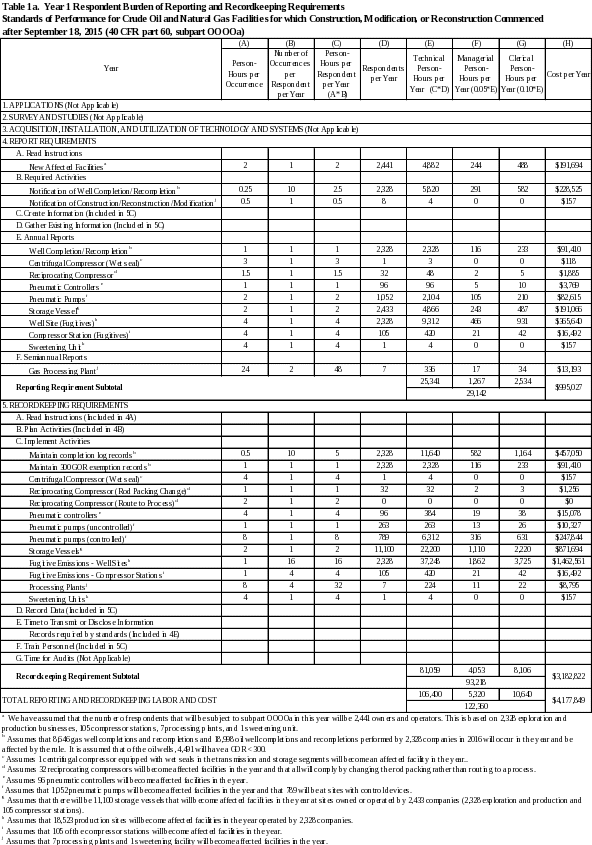
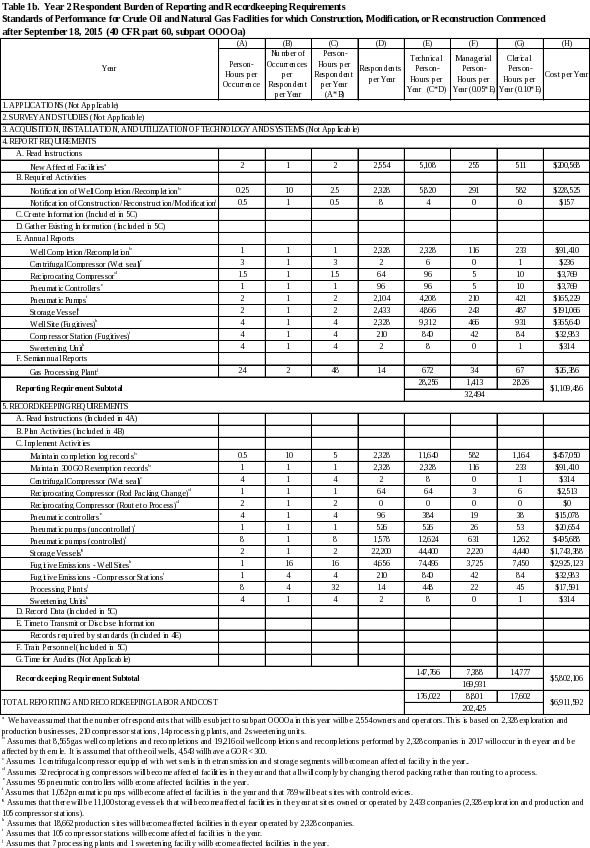
Table 1d. Three-Year Average Respondent Burden of Reporting and Recordkeeping Requirements |
||||||
Standards of Performance for Crude Oil and Natural Gas Facilities for which Construction, Modification, |
||||||
or Reconstruction Commenced after September 18, 2015 (40 CFR part 60, subpart OOOOa) |
||||||
|
|
|
|
|
|
|
Year |
Total Respondents |
Technical Hours |
Clerical Hours |
Management Hours |
Total Labor Hours |
Labor Cost |
1 |
2,441 |
59,000 |
2,950 |
5,900 |
67,850 |
$2,316,665 |
2 |
2,554 |
90,534 |
4,527 |
9,053 |
104,114 |
$3,554,863 |
3 |
2,667 |
107,262 |
5,363 |
10,726 |
123,351 |
$4,211,696 |
Total |
7,662 |
256,796 |
12,840 |
25,680 |
295,315 |
$10,083,223 |
Average |
2,554 |
85,599 |
4,280 |
8,560 |
98,438 |
$3,361,074 |
a Note that the numbers in this table do not reflect the sum of the values provided in Tables 1a, 1b and 1c. Tables 1a, 1b and 1c include the comprehensive technical, managerial, and clerical hours and associated costs for reporting and recordkeeping required by subpart OOOOa. However, the reporting and recordkeeping costs for the fugitive emission standards for components at well sites and compressor stations were also included in the total program costs estimated in the Technical Support Document (TSD) for the final standards. In order to avoid double-counting of these impacts, the hours and costs associated with this fugitive program in Tables 1a, 1b and 1c were not included in the totals reported in Table 1d and elsewhere throughout this document.
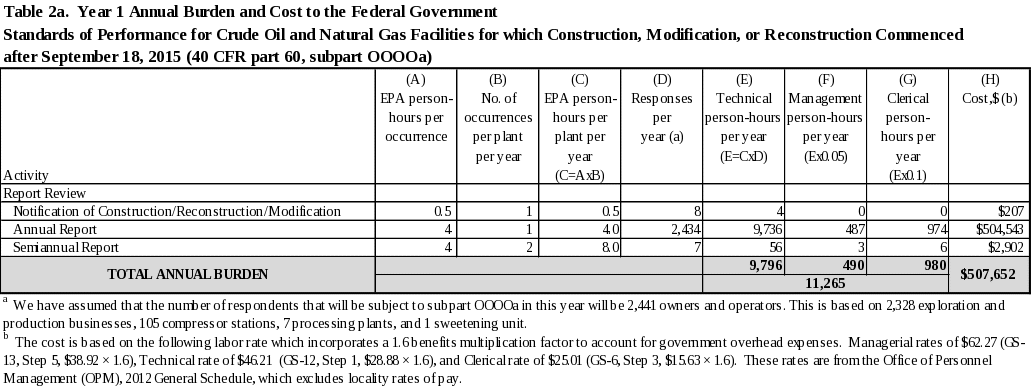
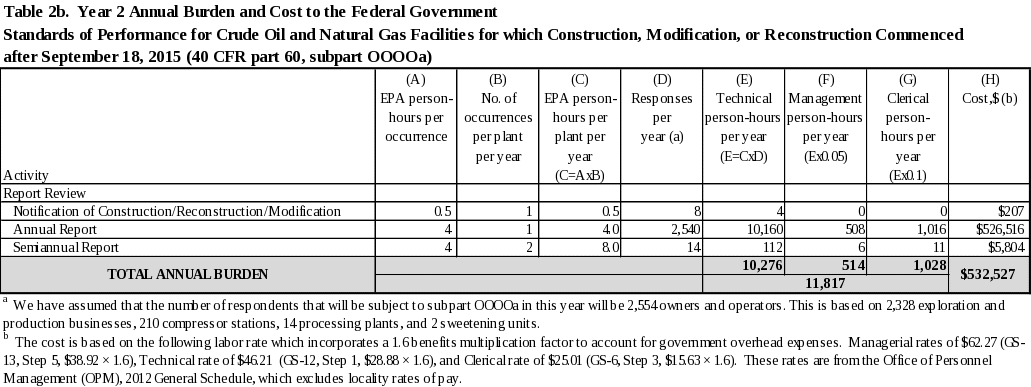
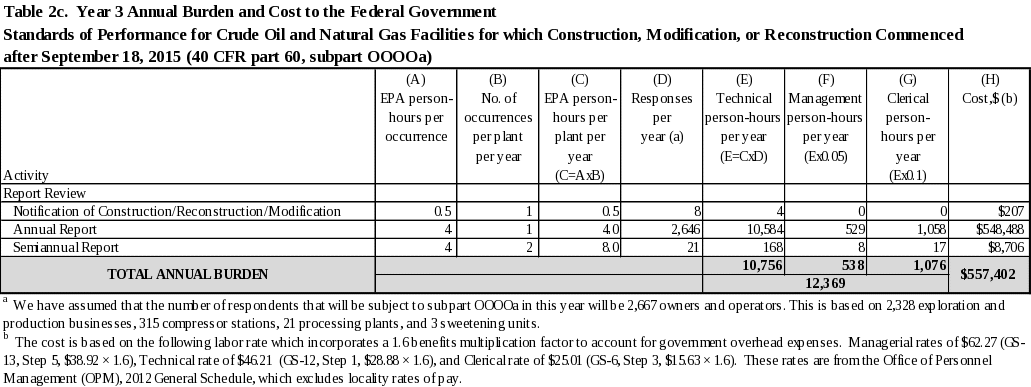

0 For example, paragraph 60.5420a(a)(2)(ii) states that “If you are subject to state regulations that require advance notification of well completions and you have met those notification requirements, then you are considered to have met the advance notification requirements of paragraph (a)(2)(i) of this section.”
| File Type | application/vnd.openxmlformats-officedocument.wordprocessingml.document |
| File Title | SUPPORTING STATEMENT |
| Author | Marvin Branscome |
| File Modified | 0000-00-00 |
| File Created | 2021-01-21 |
© 2025 OMB.report | Privacy Policy